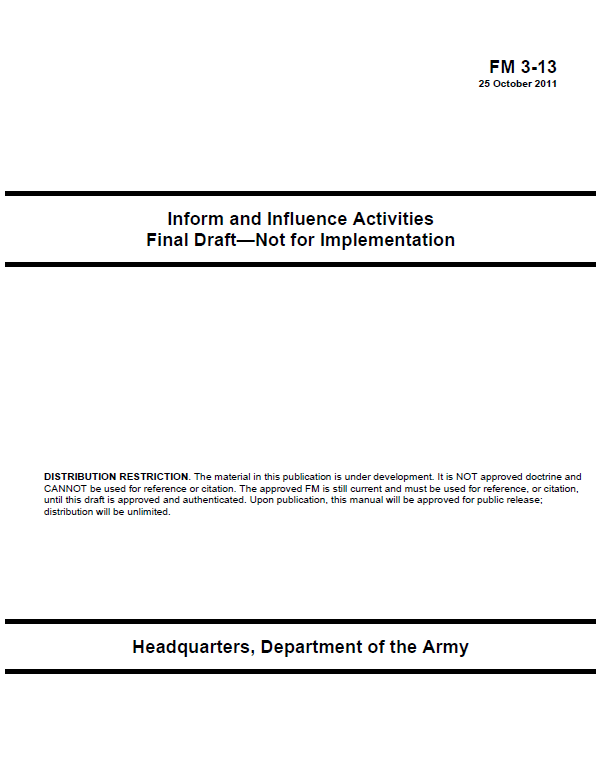The following manual is an unreleased draft version. For more information on its significance, see our article Information Operations Are Now “Inform and Influence Activities”.
FM 3-13 Inform and Influence Activities Final Draft
- 67 pages
- October 25, 2011
INFORM AND INFLUENCE ACTIVITIES DEFINED
1-1. Inform and influence activities is the integration of designated information-related capabilities in order to synchronize themes, messages, and actions with operations to inform U.S. and global audiences, influence foreign audiences, and affect adversary and enemy decisionmaking.
INTEGRATE INFORMATION-RELATED CAPABILITIES
1-2. All assets and capabilities at a commander’s disposal have the capacity to inform and influence selected audiences to varying degrees. While specific assets termed as “information-related capabilities” are information-centric in mission and purpose, others are standard capabilities that inform and influence officers use for planning to support commanders’ information strategy and mission objectives. The primary information-related capabilities that support inform and influence activities typically include, but are not limited to, public affairs, military information support operations, combat camera, Soldier and leader engagement, civil affairs, cyber electromagnetic activities, counterintelligence, operations security, military deception, and others so designated by a commander. In addition to the primary information-related capabilities, there are operational capabilities not solely designed to inform or influence that commanders can designate to assist in achieving mission objectives, such as maneuver forces, engineers, and medical units. Success depends on commanders and staffs effectively employing all available operational assets to best shape the information environment.
SYNCHRONIZE THEMES, MESSAGES, AND ACTIONS WITH OPERATIONS
1-3. Commanders synchronize themes, messages, and actions with operations to inform and influence the various audiences within their area of operations and area of interest. Audiences include groups, organizations, and individuals. Synchronization of themes, messages, and actions promotes and shapes the attitudes, values, beliefs, and behaviors of the audiences in the area of operations while marginalizing or defeating adversary or enemy information efforts towards the same. Synchronization supports the commander’s operational goals by aligning words with deeds to avoid message confusion or information fratricide. Information fratricide is the result of employing information-related capabilities operations elements in a way that causes effects in the information environment that impede the conduct of friendly operations or adversely affect friendly forces.
1-4. Soldiers’ actions are among the most potent factors in successfully executing inform and influence activities. Visible actions coordinated with carefully chosen, truthful words influence audiences more than uncoordinated or contradictory actions and words. All audiences—local and regional as well as adversary and enemy—compare the friendly force’s message with its actions. Consistency contributes to the success of friendly operations by building trust and reinforcing credibility. Conversely, if actions and messages are inconsistent, friendly forces lose credibility. Loss of credibility makes land forces vulnerable to enemy and adversary propaganda or counter-messaging and places Army forces at a disadvantage. Aligning inform and influence activities with the overall operation ensures that messages are consistent with forces’ actions to amplify the credibility of those messages.
…
MILITARY DECEPTION
3-12. Military deception involves actions executed to deliberately mislead adversary military, paramilitary, or violent extremist organization decisionmakers. This information-related capability intends the adversary to take specific actions (or inactions) that contribute to accomplishment of the friendly mission. Military deception does not fall under the direct purview of the G-7 (S-7) but is considered a primary influencing capability of inform and influence activities. Military deception consists of counterdeception, deception in support of operations security, and tactical deception.
3-13. Counterdeception contributes to situational understanding by protecting friendly human and automated decisionmaking from adversary deception. Counterdeception strives to make Army commanders aware of adversary deception activities so they can formulate informed and coordinated responses.
3-14. A deception in support of operations security protects friendly operations, personnel, programs, equipment, and other assets against foreign intelligence security services collection. It creates multiple false indicators. These indicators confuse the adversary or enemy. Sometimes they make friendly intentions harder for the adversary or enemy intelligence gathering apparatus to interpret. Often it limits the adversary or enemy’s ability to collect accurate intelligence on friendly forces.
…
CYBER ELECTROMAGNETIC ACTIVITIES
3-16. Cyber electromagnetic activities seize, retain, and exploit advantages in cyberspace and the electromagnetic spectrum. The result enables Army forces to retain freedom of action while denying freedom of action to enemies and adversaries, thereby enabling the overall operation. For more information on cyber electromagnetic operations, see FM 3-36.
3-17. Although inform and influence activities and cyber electromagnetic activities are interrelated, each requires a uniquely different skill set to perform the required processes effectively. Ultimately both work towards contributing to affecting personal cognition, and both activities are able to mutually support one another. Therefore, cyber electromagnetic activities is considered an information-related capability that must be synchronized and integrated through inform and influence activities. Not only can it reinforce messaging efforts by providing additional means for message distribution, but it is also incorporated to execute or support offensive and defensive operational planning against an adversary or enemy audience.

